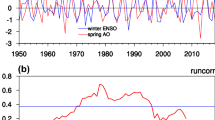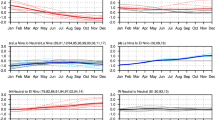Abstract
The wintertime Arctic Oscillation (AO) manifests a high degree of uncertainty in its spatial structure, which was suggested to be associated with some other extratropical atmospheric variabilities (e.g., the Aleutian-Icelandic Low seesaw and the stratospheric polar vortex). Based on reanalysis and model simulation data in 1950–2019, the present work investigates the possible effects of El Niño-Southern Oscillation (ENSO) on the AO spatial structure. It is found that there exist obvious differences in AO structure between early (November–December) and late (January–February) winter. In early winter, the AO is manifested by its traditional pattern with three action centers, one of which is over the Arctic and the other two are with the opposite sign over the North Atlantic and North Pacific. However, the AO pattern in late winter changes remarkably, resembling a regional North Atlantic Oscillation (NAO) pattern with the absence of its significant Pacific center. The noteworthy sub-seasonal variation in the AO spatial pattern can be largely ascribed to the observed fact that ENSO atmospheric teleconnections to the Northern Hemisphere are significantly enhanced in late winter compared with early winter. The enhanced ENSO-associated teleconnection during late winter can significantly weaken the teleconnectivity of the Arctic center with the Pacific center, resulting in the absence of the AO’s significant Pacific center. The understanding of ENSO impacts on the AO structure has some significance for the AO-associated climate prediction around the North Pacific region.













Similar content being viewed by others
Data availability
The data that support the findings of this study are available from the following resources: https://psl.noaa.gov/data/gridded/data.ncep.reanalysis.html; https://psl.noaa.gov/data/gridded/tables/daily.html; https://www.metoffice.gov.uk/hadobs/hadisst/data/download.html; https://esgf-node.llnl.gov/search/cmip6/.
References
Ambaum MHP, Hoskins BJ, Stephenson DB (2001) Arctic oscillation or north atlantic oscillation? J Clim 14:13
Bjerknes JB (1967) Atmospheric teleconnections from the equatorial Pacific. Mon Weather Rev 97:163–172
Bladé I, Newman M, Alexander MA, Scott JD (2008) The late fall extratropical response to ENSO: sensitivity to coupling and convection in the tropical west Pacific. J Clim 21:6101–6118. https://doi.org/10.1175/2008JCLI1612.1
Castanheira JM, Graf H-F (2003) North Pacific-North Atlantic relationships under stratospheric control? J Geophys Res Atmos. https://doi.org/10.1029/2002JD002754
Chen S, Yu B, Chen W (2014) An analysis on the physical process of the influence of AO on ENSO. Clim Dyn 42:973–989. https://doi.org/10.1007/s00382-012-1654-z
Chen S, Yu B, Chen W (2015) An interdecadal change in the influence of the spring Arctic Oscillation on the subsequent ENSO around the early 1970s. Clim Dyn 44:1109–1126. https://doi.org/10.1007/s00382-014-2152-2
Cheng Q, Tan B (2019) On the variation of the Pacific center: a revisit to the physical nature of Arctic Oscillation. Clim Dyn 53:1233–1243. https://doi.org/10.1007/s00382-018-4583-7
Choi K-S, Byun H-R (2010) Possible relationship between western North Pacific tropical cyclone activity and Arctic Oscillation. Theor Appl Climatol 100:261–274. https://doi.org/10.1007/s00704-009-0187-9
Christiansen B (2002) On the physical nature of the Arctic Oscillation. Geophys Res Lett 29:52-1-52–4. https://doi.org/10.1029/2002GL015208
Dai P, Tan B (2017) The nature of the Arctic Oscillation and diversity of the extreme surface weather anomalies it generates. J Clim 30:5563–5584. https://doi.org/10.1175/JCLI-D-16-0467.1
Deser C (2000) On the teleconnectivity of the “Arctic Oscillation.” Geophys Res Lett 27:779–782. https://doi.org/10.1029/1999GL010945
Deser C, Simpson IR, Mckinnon KA, Phillips AS (2017) The northern hemisphere extratropical atmospheric circulation response to ENSO: how well do we know it and how do we evaluate models accordingly? J Clim 30:24
Dommenget D, Latif M (2002) A cautionary note on the interpretation of EOFs. J Clim 15:10
Eyring V, Bony S, Meehl GA et al (2016) Overview of the coupled model intercomparison project phase 6 (CMIP6) experimental design and organization. Geosci Model Dev 9:1937–1958. https://doi.org/10.5194/gmd-9-1937-2016
Feldstein SB (2000) The timescale, power spectra, and climate noise properties of teleconnection patterns. J Clim 13:4430–4440. https://doi.org/10.1175/1520-0442(2000)013%3c4430:TTPSAC%3e2.0.CO;2
Feldstein SB, Franzke C (2006) Are the North Atlantic Oscillation and the northern annular mode distinguishable? J Atmos Sci 63:2915–2930. https://doi.org/10.1175/JAS3798.1
Fisher RA (1915) Frequency distribution of the values of the correlation coefficient in samples from an indefinitely large population. Biometrika 10:507–521. https://doi.org/10.2307/2331838
Fisher RA (1921) On the’probable error’of a coefficient of correlation deduced from a small sample. Metron 1:1–32
Gong H, Wang L, Chen W et al (2017) Biases of the wintertime Arctic Oscillation in CMIP5 models. Environ Res Lett 12:014001. https://doi.org/10.1088/1748-9326/12/1/014001
Gong H, Wang L, Chen W, Nath D (2018) Multidecadal fluctuation of the wintertime arctic oscillation pattern and its implication. J Clim 31:5595–5608. https://doi.org/10.1175/JCLI-D-17-0530.1
Gong H, Wang L, Chen W et al (2019a) Diversity of the Wintertime Arctic Oscillation Pattern among CMIP5 Models: role of the Stratospheric Polar Vortex. J Clim 32:5235–5250. https://doi.org/10.1175/JCLI-D-18-0603.1
Gong H, Wang L, Chen W (2019b) Multidecadal changes in the influence of the arctic oscillation on the east asian surface air temperature in boreal winter. Atmosphere 10:757. https://doi.org/10.3390/atmos10120757
Honda M (2001) Interannual seesaw between the aleutian and icelandic lows. Part II: its significance in the interannual variability over the wintertime northern hemisphere. J Clim 14:19
Honda M, Yamane S, Nakamura H (2005) Impacts of the aleutian-icelandic low seesaw on surface climate during the twentieth century. J Clim 18:2793–2802. https://doi.org/10.1175/JCLI3419.1
Horel JD, Wallace JM (1981) Planetary-scale atmospheric phenomena associated with the Southern Oscillation. Mon Weather Rev 109:813–829. https://doi.org/10.1175/1520-0493(1981)109%3c0813:PSAPAW%3e2.0.CO;2
Ineson S, Scaife AA (2009) The role of the stratosphere in the European climate response to El Niño. Nat Geosci 2:32–36. https://doi.org/10.1038/ngeo381
Itoh H (2008) Reconsideration of the true versus apparent arctic oscillation. J Clim 21:2047–2062. https://doi.org/10.1175/2007JCLI2167.1
Itoh H, Mori A, Yukimoto S (2007) Independent components in the northern hemisphere winter: is the arctic oscillation independent? J Meteorol Soc Jpn Ser II 85:825–846. https://doi.org/10.2151/jmsj.85.825
Kaiser HF (1958) The varimax criterion for analytic rotation in factor analysis. Psychometrika 23:187–200. https://doi.org/10.1007/BF02289233
Kalnay E, Kanamitsu M, Kistler R et al (1996) The NCEP/NCAR 40-year reanalysis project. Bull Am Meteorol Soc 77:437–472. https://doi.org/10.1175/1520-0477(1996)077%3c0437:TNYRP%3e2.0.CO;2
Kim S, Son H-Y, Kug J-S (2018) Relative roles of equatorial central Pacific and western North Pacific precipitation anomalies in ENSO teleconnection over the North Pacific. Clim Dyn 51:4345–4355. https://doi.org/10.1007/s00382-017-3779-6
Livezey RE, Mo KC (1987) Tropical-extratropical teleconnections during the northern hemisphere winter. Part II: relationships between monthly mean northern hemisphere circulation patterns and proxies for tropical convection. Mon Weather Rev 115:3115–3132. https://doi.org/10.1175/1520-0493(1987)115%3c3115:TETDTN%3e2.0.CO;2
Livezey RE, Masutani M, Leetmaa A et al (1997) Teleconnective response of the Pacific-North American region atmosphere to large central equatorial Pacific SST anomalies. J Clim 10:1787–1820. https://doi.org/10.1175/1520-0442(1997)010%3c1787:TROTPN%3e2.0.CO;2
Lorenz DJ, Hartmann DL (2003) Eddy-Zonal flow feedback in the northern hemisphere winter. J Clim 16:1212–1227. https://doi.org/10.1175/1520-0442(2003)16%3c1212:EFFITN%3e2.0.CO;2
Mao R, Gong D, Yang J, Bao J (2011) Linkage between the Arctic Oscillation and winter extreme precipitation over central-southern China. Clim Res 50:187–201. https://doi.org/10.3354/cr01041
Miller RL, Schmidt GA, Shindell DT (2006) Forced annular variations in the 20th century Intergovernmental Panel on Climate Change Fourth Assessment Report models. J Geophys Res 111:D18101. https://doi.org/10.1029/2005JD006323
Mori A, Kawasaki N, Yamazaki K et al (2006) A reexamination of the Northern Hemisphere Sea level pressure variability by the independent component analysis. SOLA 2:5–8. https://doi.org/10.2151/sola.2006-002
Moron V, Gouirand I (2003) Seasonal modulation of the El Niño–southern oscillation relationship with sea level pressure anomalies over the North Atlantic in October–March 1873–1996. Int J Climatol 23:143–155. https://doi.org/10.1002/joc.868
Nakamura T, Tachibana Y, Honda M, Yamane S (2006) Influence of the Northern Hemisphere annular mode on ENSO by modulating westerly wind bursts. Geophys Res Lett 33:L07709. https://doi.org/10.1029/2005GL025432
Neelin JD, Battisti DS, Hirst AC et al (1998) ENSO theory. J Geophys Res Oceans 103:14261–14290. https://doi.org/10.1029/97JC03424
Newman M, Sardeshmukh PD (1998) The impact of the annual cycle on the North Pacific/North American response to remote low-frequency forcing. J Atmos Sci 55:1336–1353. https://doi.org/10.1175/1520-0469(1998)055%3c1336:TIOTAC%3e2.0.CO;2
Philander SG (2018) El Niño, La Niña, and the Southern Oscillation. Princeton University Press
Rayner NA, Parker DE, Horton EB et al (2003) Global analyses of sea surface temperature, sea ice, and night marine air temperature since the late nineteenth century. J Geophys Res Atmos. https://doi.org/10.1029/2002JD002670
Sardeshmukh PD, Hoskins BJ (1988) The generation of global rotational flow by steady idealized tropical divergence. J Atmos Sci 45:1228–1251. https://doi.org/10.1175/1520-0469(1988)045%3c1228:TGOGRF%3e2.0.CO;2
Shi N, Nakamura H (2014) Multi-decadal modulations in the Aleutian-Icelandic low seesaw and the axial symmetry of the Arctic Oscillation signature, as revealed in the 20th century reanalysis. Tellus Dyn Meteorol Oceanogr 66:22660. https://doi.org/10.3402/tellusa.v66.22660
Smith KL, Kushner PJ (2012) Linear interference and the initiation of extratropical stratosphere-troposphere interactions. J Geophys Res Atmos. https://doi.org/10.1029/2012JD017587
Stoner AM, Hayhoe K, Wuebbles D (2009) Assessing general circulation model simulations of atmospheric teleconnection patterns. J Clim 22:4348–4372. https://doi.org/10.1175/2009JCLI2577.1
Thompson DWJ, Wallace JM (1998) The Arctic oscillation signature in the wintertime geopotential height and temperature fields. Geophys Res Lett 25:1297–1300. https://doi.org/10.1029/98GL00950
Thompson DWJ, Wallace JM (2000) Annular modes in the extratropical circulation part I: month-to-month variability. J Clim 13:17
Thompson DWJ, Wallace JM (2001) Regional climate impacts of the northern hemisphere annular mode. Sci New Ser 293:85–89
Wallace JM, Thompson DWJ (2002) The Pacific Center of action of the northern hemisphere annular mode: real or artifact? J Clim 15:5
Wang D (2005) Winter Northern Hemisphere surface air temperature variability associated with the Arctic Oscillation and North Atlantic Oscillation. Geophys Res Lett 32:L16706. https://doi.org/10.1029/2005GL022952
Wang H, Fu R (2000) Winter monthly mean atmospheric anomalies over the North Pacific and North America Associated with El Nino SSTs. J Clim 13:13
Yukimoto S, Kawai H, Koshiro T et al (2019) The Meteorological Research Institute Earth System Model Version 2.0, MRI-ESM2.0: description and basic evaluation of the physical component. J Meteorol Soc Jpn 97:931–965. https://doi.org/10.2151/jmsj.2019-051
Funding
This work was funded by the National Nature Science Foundation of China (42125501 and 42088101).
Author information
Authors and Affiliations
Corresponding author
Ethics declarations
Conflict of interest
The authors have no relevant financial or non-financial interests to disclose.
Additional information
Publisher's Note
Springer Nature remains neutral with regard to jurisdictional claims in published maps and institutional affiliations.
Rights and permissions
Springer Nature or its licensor holds exclusive rights to this article under a publishing agreement with the author(s) or other rightsholder(s); author self-archiving of the accepted manuscript version of this article is solely governed by the terms of such publishing agreement and applicable law.
About this article
Cite this article
Hu, S., Zhang, W., Jiang, F. et al. Understanding the sub-seasonal variation in the wintertime AO spatial pattern from the viewpoint of El Niño-Southern Oscillation. Clim Dyn 60, 3629–3643 (2023). https://doi.org/10.1007/s00382-022-06533-5
Received:
Accepted:
Published:
Issue Date:
DOI: https://doi.org/10.1007/s00382-022-06533-5




